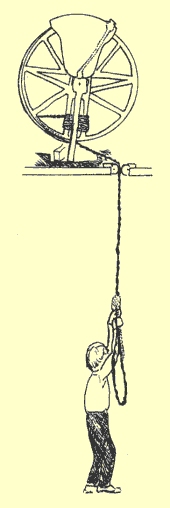Bell Ringers
Bells have rung in St. George’s Church Pontesbury for nearly 500 years. The first record is of “three great bells and a sanctus bell” in 1549.
Five of the present ring of six bells were cast in 1681 by Thomas Roberts, a Shrewsbury bell founder. They range in weight from the lightest, 6cwt, to the tenor, the heaviest, 13cwt, and are tuned to ring the notes C#, B, A#, G# and F#. These five are the only known surviving ring of bells cast by Thomas Roberts. The present treble, 5cwt, D#, was added in 1869.
Bells have played an important part in the history of our village. In the 19th century a curfew bell was being rung in Pontesbury from 5th November until Christmas; the unusual custom of tolling 13 times at a man’s funeral and 12 for a woman’s was still observed in about 1900; ringing for Sunday services took place with chiming at 8am after which the day of the month was tolled. There was a clock in the tower in 1788, while the present one was bought and installed in 1858.
The six bells are hanging in the belfry, behind the louvered windows at the top of the tower. Each hangs mouth downwards within a strong wooden frame, having a large wheel to the side, around which the bell rope is fixed. The bell ropes pass down the tower via holes in floor and ceiling, through the clock room to the ringing room below. There are trap doors in the floors/ceilings of the tower rooms, for use in hoisting the bells up to the belfry.


Before the ringers can ring and control the bells, each has to be ‘rung up’, pulling on the ropes to make the bell swing higher and higher until it comes to rest upside down in the frame.
‘Change ringing’ is a centuries old custom peculiar to English churches, which began in the City of London during the reign of Queen Elizabeth I. Change ringing means ‘making music’ with the bells, by ringing them in different orders. It is a skill involving both mental and physical exercise, but above all teamwork. The simplest pattern (or tune) which can then be rung is rounds, where the bells are rung in sequence, 123456,123456 etc. To vary the pattern the bells can be called, one by one, each to follow another specific bell. This is known as ringing Call Changes.
For example, the call ‘3 to the treble’ would produce from rounds, the sequence 132456, as bell number 3 rings after bell number 1 instead of after number 2.
With six bells there are 720 different sequences that can be rung. More advanced ringing, utilising as many of these sequences as possible, one after the other without a break, requires the ringers each to learn particular methods, and it is here that concentration and teamwork come to the fore.

We are a small and relatively inexperienced band of ringers. We ring as often as we can on a Sunday morning to call people to join the morning church service; we ring to celebrate weddings and other important local or national events and we ring the bells half muffled on Remembrance Sunday, as we might also do for a funeral.
We hope the bells in Pontesbury will continue to ring for years to come, but we always welcome more ringers to join the team, especially as we are now few in number. If you already know how to handle a bell but would like to return to ringing after a break, or if you would like to learn, then do join us on a Thursday evening when we have our practice sessions.
Please contact …
Sheila Bower, the Tower Captain, 01743 790294
These notes have been compiled from an article written by Steve Cowling, who was for many years the Bell Tower Captain in Pontesbury.

